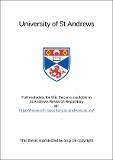Files in this item
Automated identification and network analyses in 'Acacia' pollination ecology
Item metadata
| dc.contributor.advisor | Willmer, Pat | en |
| dc.contributor.advisor | O'Neill, Mark | en |
| dc.contributor.author | Watson, Anna T. (Anna Tamsin) | en |
| dc.coverage.spatial | 222 p : ill. (some col.) 30 cm. + 2 computer laser optical discs (4 3/4 in.) | en |
| dc.date.accessioned | 2021-04-08T08:59:14Z | |
| dc.date.available | 2021-04-08T08:59:14Z | |
| dc.date.issued | 2006 | |
| dc.identifier.uri | https://hdl.handle.net/10023/21890 | |
| dc.description.abstract | Acacia trees are an important source of pollen and nectar to a wide range of savannah insects. Identifying Acacia-visiting insects and the herb pollens they also carry is essential for pollination studies but problematic as expert entomologists and palynologists are overworked. Automated identification offers a solution to this problem. The DAISY automated identification system can identify insects accurately but the pattern selection methodology has been time consuming and impractical for large applications. Two new methodological approaches are investigated that allow quicker processing or avoid wing removal. They showed great promise, identifying species with more than 90% accuracy. Pollens provide very different challenges to computer vision, they are three dimensional, often vary substantially within a single species and have complex shapes. In the initial DAISY identification of pollens accuracy was low (34% at best) so several methodological means to improve accuracy were investigated. The processing regime recommended for greatest accuracy is clean pollens, imaged with dark field microscopy and which had their relative sizes maintained. Cleaned and sized pollens were identified with 100% accuracy when only 5 pollens were considered but this fell to around 50% accuracy when 50+ pollens were considered. As most applications will require many pollens to be considered at once this is not yet a useful system for pollens. Network analysis is a recent technique in pollination ecology, well suited to pollen load analysis. The most important insects to the pollination network were all bees: Apis mellifera, Megachile and the small halictids Lipotriches and Patellapis. The damage from removing a single insect genus was generally below 5% and never more than 10% of network integrity. Removal of combinations of insects showed great tolerance to extinction, this is likely to be due to functional redundancy and nestedness of the network, with specialists visiting plants that are also visited by generalists. | |
| dc.language.iso | en | en |
| dc.publisher | University of St Andrews | en |
| dc.subject.lcc | QK926.W2 | |
| dc.subject.lcsh | Insects--Identification--Automation | en |
| dc.subject.lcsh | Pollen--Identification--Automation | en |
| dc.subject.lcsh | Insect-plant relationships--Network analysis | en |
| dc.subject.lcsh | Pollination by insects | en |
| dc.subject.lcsh | Acacia--Kenya | en |
| dc.title | Automated identification and network analyses in 'Acacia' pollination ecology | en |
| dc.type | Thesis | en |
| dc.type.qualificationlevel | Doctoral | en |
| dc.type.qualificationname | MPhil Master of Philosophy | en |
| dc.publisher.institution | The University of St Andrews | en |
This item appears in the following Collection(s)
Items in the St Andrews Research Repository are protected by copyright, with all rights reserved, unless otherwise indicated.

